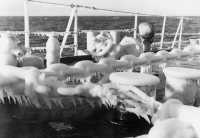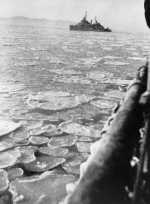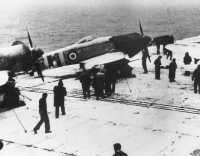Australian ships in the Korean War
Destroyers: Bataan, Warramunga, Tobruk and ANZAC
Frigates: Shoalhaven, Murchison, Condamine and Culgoa
Aircraft carrier: Sydney
A heavily iced HMAS Anzac on patrol off the North Korean Coast. (AWM P0444/214/088)
Korea is surrounded by water on three sides. Sea power was crucial to the UN forces in the Korean War as the Chinese and North Koreans outnumbered UN ground forces. Control of Korean waters enabled the UN forces to launch the Inchon landing, which altered the course of the war.

A heavily iced HMAS Anzac on patrol off the North Korean Coast. (AWM P0444/214/088)
Like to copy this image? Please click here first
The UN forces soon took advantage of their superior naval forces and seized control of Korea's long coastlines, using many ships to transport large numbers of troops and supplies throughout the war. The use of aircraft carriers, including HMAS Sydney, increased the numbers of aircraft available to the UN forces, enabling complete air coverage of the Korean peninsula.
On 1 July 1950, the Australian frigate HMAS Shoalhaven and the destroyer HMAS Bataan joined a fleet enforcing the UN blockade. A month later, Bataan saw its first action when shots were exchanged with a North Korean shore battery. Other RAN ships were deployed shortly thereafter, bombarding shore installations and supply lines.
On 1 July 1950, the Australian frigate HMAS Shoalhaven and the destroyer HMAS Bataan joined a fleet enforcing the UN blockade. A month later, Bataan saw its first action when shots were exchanged with a North Korean shore battery. Other RAN ships were deployed shortly thereafter, bombarding shore installations and supply lines.
Navy warships operating in the icy waters on the west coast of North Korea. (AWM 042343)
After mid -1951 and the beginning of negotiations between the two sides, naval pressure was increased against Communist ground forces by bombardments and blockades. HMAS Murchison played an important role in a naval blockade of the Han River from July to September 1952, Operation Han. For the last two years of the war, RAN ships in Korean waters continued to protect the islands off the west coast of North Korea that were in South Korean possession.

Navy warships operating in the icy waters on the west coast of North Korea. (AWM 042343)
Like to copy this image? Please click here first
Naval Air Power
HMAS Sydney, an Australian light aircraft carrier, joined the war at sea in late 1951.
Air squadrons flying from HMAS Sydney were 805 Squadron, 808 Squadron and 817 Squadron.
Sea Fury and Firefly aircraft of the recently formed Australian Fleet Air Arm, flown off HMAS Sydney, supported hard-pressed ground forces with rockets, bombs and cannon fire. They also flew combat air patrols to protect Sydney from enemy air attack.

With snow and ice covering the flight deck, members of the crew of HMAS Sydney prepare Sea Fury aircraft for missions over enemy territory. (AWM P01838.013)
Like to copy this image? Please click here first
Living Conditions
Australian Naval personnel in Korea endured severe hardships. Not only were the waters mined, but also operations had to continue in appalling weather.
In winter, snow and ice covered the ships' decks, and sailors lived in cramped and often freezing quarters. Large naval guns were operated every ten minutes to ensure they did not freeze up.
In summer and autumn, typhoons brought rough seas and winds of up to 160 kilometres per hour.
(Extract from Out in the Cold, The Australian War Memorial's online exhibition on Korea)





